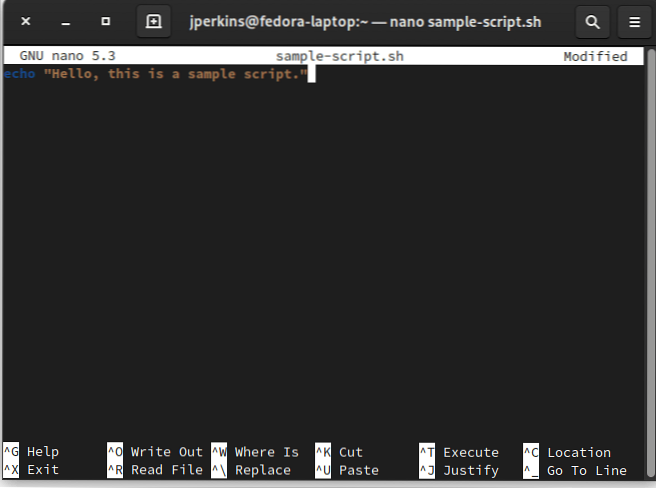- What is a shebang in Linux?
- How does shebang work?
- What is the use of shebang in Unix?
- Why do we use shebang?
- How do you write a shebang line?
- What is $? In Unix?
- What is Python shebang?
- Does shebang have to be first line?
- How do I know my current shell?
- What is difference between bash and sh?
- How do bash scripts work?
- How do I run a shell script?
What is a shebang in Linux?
It is called a shebang or a "bang" line. It is nothing but the absolute path to the Bash interpreter. It consists of a number sign and an exclamation point character (#!), followed by the full path to the interpreter such as /bin/bash. All scripts under Linux execute using the interpreter specified on a first line.
How does shebang work?
The shebang is a special character sequence in a script file that specifies which program should be called to run the script. ... Many scripting languages, such as Perl, use the # character to indicate the beginning of a comment line that should be ignored by the interpreter.
What is the use of shebang in Unix?
When a text file with a shebang is used as if it is an executable in a Unix-like operating system, the program loader mechanism parses the rest of the file's initial line as an interpreter directive.
Why do we use shebang?
The shebang is used if you run the script directly as an executable file (for example with the command ./script.sh ). In this case it tells the operating system which executable to run. It's not required and has no effect if you for example write bash ./script.sh or source the script.
How do you write a shebang line?
Starting a Script With #! It is called a shebang or a "bang" line. It is nothing but the absolute path to the Bash interpreter. It consists of a number sign and an exclamation point character (#!), followed by the full path to the interpreter such as /bin/bash.
What is $? In Unix?
$? -The exit status of the last command executed. $0 -The filename of the current script. $# -The number of arguments supplied to a script. $$ -The process number of the current shell. For shell scripts, this is the process ID under which they are executing.
What is Python shebang?
#!/usr/bin/env python """ The first line in this file is the "shebang" line. When you execute a file from the shell, the shell tries to run the file using the command specified on the shebang line. The ! is called the "bang". ... The shebang line specifies exactly how to run a script.
Does shebang have to be first line?
4 Answers. The shebang must be the first line because it is interpreted by the kernel, which looks at the two bytes at the start of an executable file. ... Since the kernel will only look at the first two characters and has no notion of further lines, you must place the hash bang in line 1.
How do I know my current shell?
How to check which shell am I using: Use the following Linux or Unix commands: ps -p $$ – Display your current shell name reliably. echo "$SHELL" – Print the shell for the current user but not necessarily the shell that is running at the movement.
What is difference between bash and sh?
bash and sh are two different shells. Basically bash is sh, with more features and better syntax. ... Bash stands for "Bourne Again SHell",and is a replacement/improvement of the original Bourne shell (sh). Shell scripting is scripting in any shell, whereas Bash scripting is scripting specifically for Bash.
How do bash scripts work?
A Bash script is a plain text file which contains a series of commands. These commands are a mixture of commands we would normally type ouselves on the command line (such as ls or cp for example) and commands we could type on the command line but generally wouldn't (you'll discover these over the next few pages).
How do I run a shell script?
Steps to write and execute a script
- Open the terminal. Go to the directory where you want to create your script.
- Create a file with . sh extension.
- Write the script in the file using an editor.
- Make the script executable with command chmod +x <fileName>.
- Run the script using ./<fileName>.
 Naneedigital
Naneedigital



